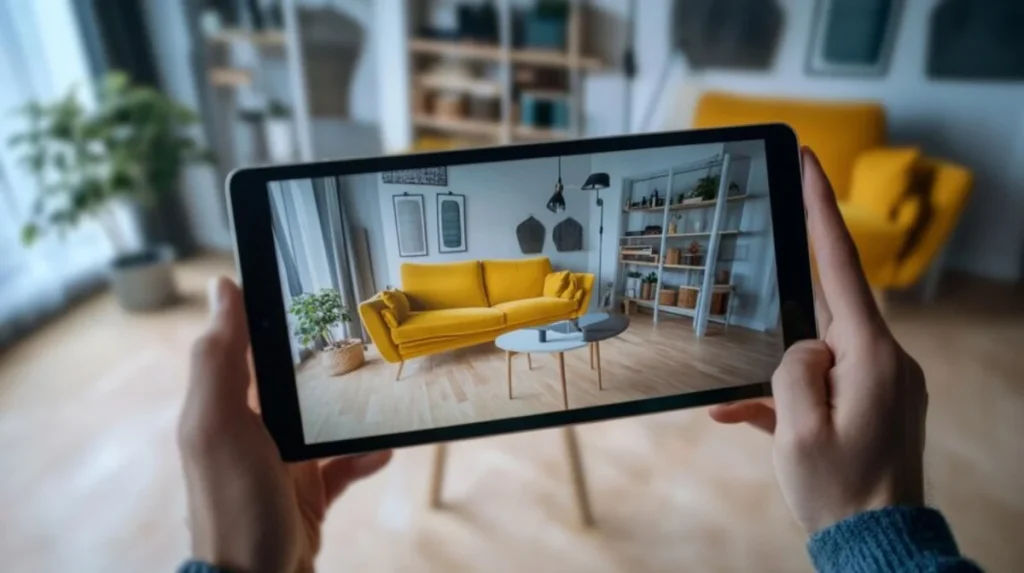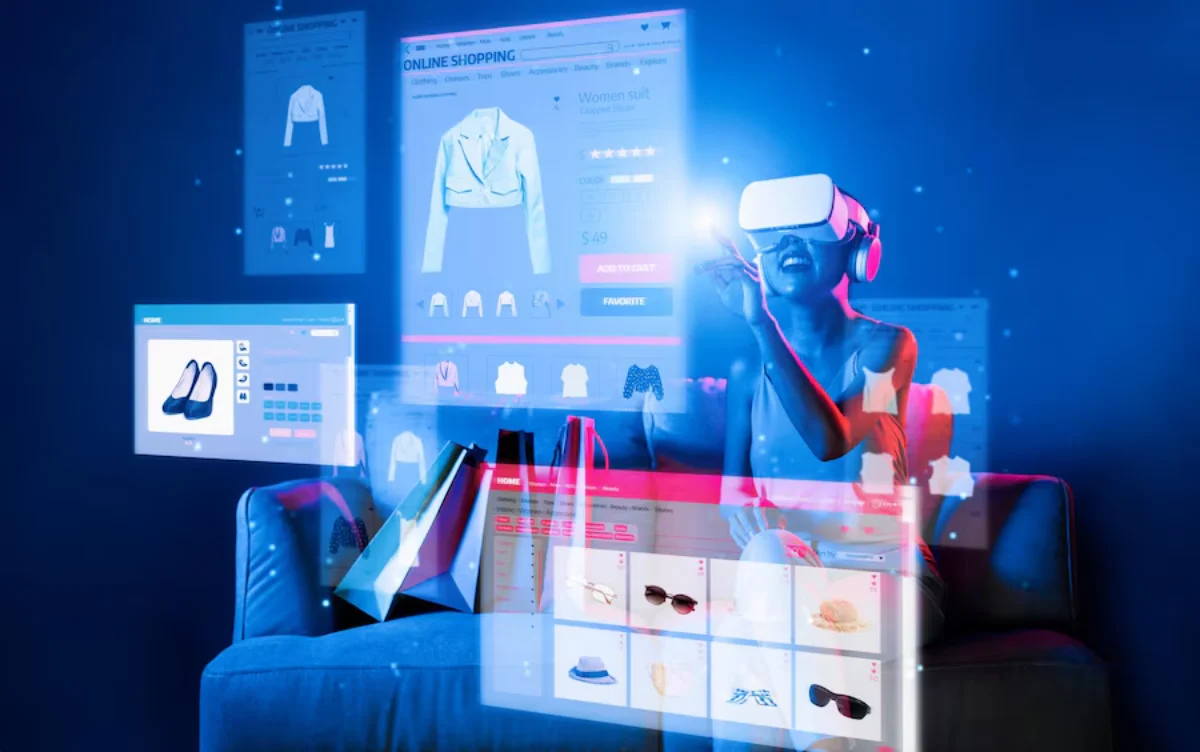The E-commerce Blog

How AR is Transforming Online Shopping Experiences
The Rise of Augmented Reality in E-commerce
E-commerce has rapidly evolved over the past decade, offering consumers new and innovative ways to shop online. One of the most exciting technological advancements in the industry is Augmented Reality (AR). AR is changing online shopping. It connects physical and digital retail. Now, shoppers can see products in real life before buying.
Augmented reality shopping is on the rise. Now, consumers can try on clothes, test furniture placement, and see how makeup looks on their skin—all from home. This technology isn’t just a gimmick. It boosts customer experience, lowers return rates, and builds buyer confidence.
This article looks at AR e-commerce. We’ll discuss its benefits, key applications, and how businesses can use virtual try-on technology. This can help them stay ahead in online retail.
The Role of AR in Enhancing Online Shopping Experiences

What is Augmented Reality Shopping?
Augmented Reality (AR) adds digital images, animations, or information to the real world. You can see this through a smartphone, tablet, or AR-enabled device. In e-commerce, this means customers can engage with products more deeply than with regular images or videos.
Key Features of AR in Online Shopping:
- Virtual product trials – Customers can see how clothing, accessories, or makeup will look on them using AR.
- 3D product visualisation – Allows users to view products in detail and from different angles.
- Interactive product placement – Consumers can place furniture, home décor, and other items in their space before buying.
- Live AR filters and effects – These are used in beauty and fashion retail to enhance the shopping experience.
Thanks to AR technology, brands can create interactive and personalised shopping experiences. This meets the expectations of today’s consumers.
Benefits of AR in E-commerce
1. Enhanced Customer Engagement
AR transforms static product pages into interactive shopping experiences. Customers engage more with a brand when they can see products. This leads to longer visits to websites and higher conversion rates.
Example: Sephora’s Virtual Artist feature allows customers to try on different makeup products using AR. This increases product interaction and customer confidence before purchasing.
2. Reduced Return Rates
A major challenge in online shopping is the high return rate. This often happens because of wrong sizing, colour differences, or unmet expectations. AR e-commerce helps customers make smarter choices. They can see how products will look in real life.
Statistic: A study by Shopify found that products using AR experiences had a 40% lower return rate compared to those without AR integration.
3. Increased Conversion Rates and Sales
AR lets customers try products virtually. This helps ease any doubts they may have about buying. When shoppers can see how an item fits into their lives, they are more likely to complete a purchase.
Example: IKEA’s IKEA Place app lets users visualise furniture in their homes. This leads to higher conversion rates and improved customer satisfaction.

4. Personalised Shopping Experience
AR-powered virtual try-on technology enables brands to offer a highly personalised shopping experience. Customers can adjust product features, customise colours, and find the perfect fit before checking out.
Example: Warby Parker’s virtual try-on tool helps customers try different glasses styles. This ensures they select the best frame for their face shape.
5. Competitive Advantage for Brands
As more retailers adopt AR, those who fail to integrate it may fall behind. Companies that invest in augmented reality shopping stand out. They provide a tech-driven experience that appeals to modern, tech-savvy shoppers.
Example: Nike’s AR fitting tool helps customers find the right shoe size by scanning their feet. This reduces sizing issues and increases satisfaction.
How Different Retail Sectors are Using AR
1. Fashion and Apparel
The fashion industry has been one of the earliest adopters of AR e-commerce. Brands are introducing virtual try-on technology for clothing, accessories, and footwear.
Applications:
- Virtual dressing rooms (e.g., Zara’s AR shopping app)
- AR-powered sunglasses and accessory trials (e.g., Ray-Ban Virtual Try-On)
- Customisable sneaker and apparel designs (e.g., Adidas AR experience)
2. Beauty and Cosmetics
Makeup and skincare brands use AR so customers can try products virtually before buying.
Applications:
- Virtual makeup try-on (e.g., L’Oréal’s AR beauty tech)
- Skin tone matching for foundation selection (e.g., Fenty Beauty’s AR colour match)
- Augmented reality mirrors in physical stores (e.g., Charlotte Tilbury’s magic mirror)
3. Home Décor and Furniture
Furniture retailers use AR tools to help customers see how items fit in their homes before buying.
Applications:
- 3D product placement in real-life environments (e.g., IKEA Place app)
- Virtual interior design planning (e.g., Wayfair’s AR shopping experience)
4. Eyewear and Accessories
Brands selling eyewear and jewellery use AR virtual try-on tools to help customers find the perfect fit and style.
Applications:
- Virtual glasses fitting (e.g., Warby Parker’s AR try-on)
- Customisable jewellery experiences (e.g., Pandora’s virtual ring try-on)
How to Implement AR in an E-commerce Business
1. Choose the Right AR Technology
Businesses need to choose the right AR tools and platforms to use augmented reality for shopping. Options include:
- Mobile AR applications – Standalone apps providing immersive AR experiences.
- Web-based AR – AR features directly embedded in e-commerce websites.
- Social media AR filters – AR experiences integrated into platforms like Instagram and Snapchat.
2. Partner with AR Developers
Retailers can team up with AR tech providers like Snapchat, Google ARCore, Apple ARKit, and Shopify. Together, they can create custom solutions.
3. Optimise for User Experience
- Ensure AR tools are easy to use and accessible.
- Keep loading times fast to avoid frustrating users.
- Offer step-by-step guidance to enhance the user experience.
4. Educate Consumers on AR Features
Many customers are still unfamiliar with AR shopping. Providing tutorials, demos, and interactive guides can help boost adoption rates.
The Future of AR in Online Shopping
AR technology is advancing. Everybody can expect more AI-powered virtual shopping assistants. Gesture-based interactions will also grow. Plus, AR experiences will become more realistic.
Predictions for AR in E-commerce:
- AI-powered personalisation – Smart AR assistants recommend products based on preferences.
- Haptic feedback in AR shopping – Simulating the sense of touch to enhance the shopping experience.
- Integration with Metaverse shopping – Creating fully immersive virtual shopping malls.
Virtual try-on tech and AR e-commerce are growing fast. Businesses that use this technology now will shape the future of online shopping.
Why AR is the Future of Online Shopping
Augmented reality shopping is no longer a futuristic concept. It’s here, transforming the way consumers interact with online retailers. AR boosts customer satisfaction by providing engaging, tailored experiences. This leads to fewer returns and increased sales.
Key Takeaways:
- AR boosts engagement and conversion rates.
- Virtual try-ons reduce returns and improve confidence.
- Brands that integrate AR gain a competitive advantage.
- The future of e-commerce lies in AI-driven AR experiences.
As AR technology grows, businesses using augmented reality e-commerce will stand out. They will lead the online retail market. Now is the time to invest in AR and create an unforgettable shopping experience for your customers.









